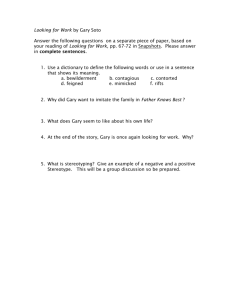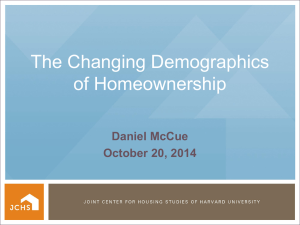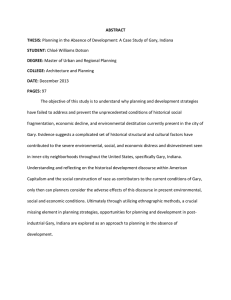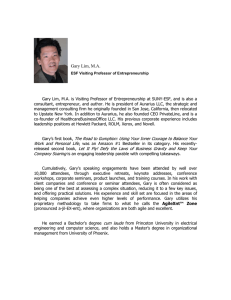Housing Finance Policy Center Lunchtime Data Talk Housing America’s Seniors:
advertisement
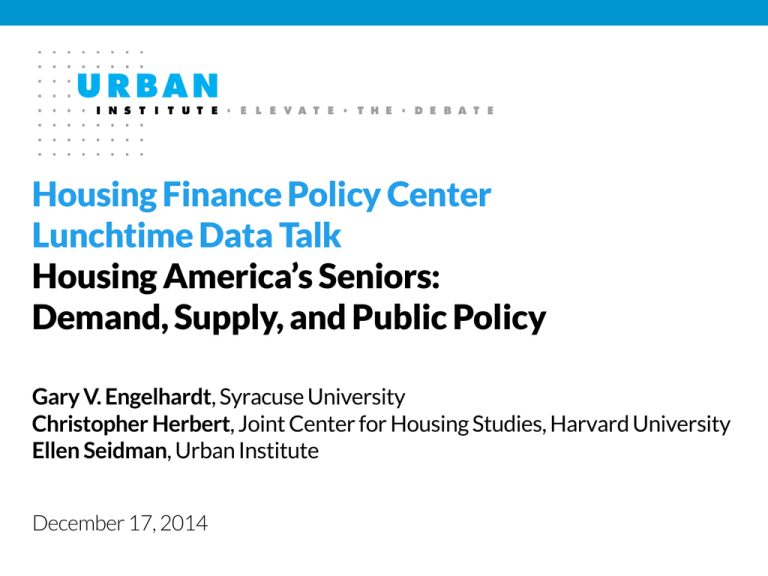
Housing Finance Policy Center Lunchtime Data Talk Housing America’s Seniors: Demand, Supply, and Public Policy Gary V. Engelhardt, Syracuse University Christopher Herbert, Joint Center for Housing Studies, Harvard University Ellen Seidman, Urban Institute December 17, 2014 Housing America’s Seniors: Demand, Supply and Public Policy Urban Institute December 17, 2014 © PRESIDENT AND FELLOW S OF HARVARD COLLEGE The Older Population Is on Track to Increase Dramatically Population by Age Group (Millions) 70 60 50 40 30 20 10 0 50–64 1990 80 and Over 65–79 2000 2010 2020 2030 2040 Source: US Census Bureau, Decennial Censuses and 2012 National Population Projections (middle series). 3 © PRESIDENT AND FELLOW S OF HARVARD COLLEGE While the Older Population is Growing Very Rapidly, The Ranks of Younger Adults Will Also Expand Population by Age Group (Millions) 25 20 15 10 5 0 2012 2040 Source: US Census Bureau, 2012 National Population Projections (middle series). 4 © PRESIDENT AND FELLOW S OF HARVARD COLLEGE By 2010, Communities Across the Country Had High Concentrations of Older Residents Share of County Population Aged 50 and Over (Percent) Under 25 25–39 40 and Over Source: JCHS tabulations of US Census Bureau, 2010 Decennial Census. 5 © PRESIDENT AND FELLOW S OF HARVARD COLLEGE Most Older Households Live as Couples or On Their Own Share of Households by Age Group (Percent) 60 50 40 30 20 10 0 Single Person Couples without Children Families with Children Other Family Household Composition 50–59 60–69 70–79 80 and Over Notes: Families with children include single parents and couples with children under age 18 living at home. Other family includes all households with two or more related adults. Data exclude non-family households, which account for less than 2 percent of households at age levels shown. Source: JCHS tabulations of US Census Bureau, 2013 Current Population Survey. 6 © PRESIDENT AND FELLOW S OF HARVARD COLLEGE Minorities Will Account for An Increasing Share of The Population in Coming Years, But Smaller Shares of the Oldest Individuals Age 50-64 Age 65-79 Age 80+ 2012 2020 2030 2040 2050 Total 2012 2020 2030 2040 2050 60 2012 2020 2030 2040 2050 Minority Population (Percent) 50 40 30 20 10 2012 2020 2030 2040 2050 0 Black Hispanic Asian/Other Source: US Census Bureau, Population Projections, 2012 (middle series). 7 © PRESIDENT AND FELLOW S OF HARVARD COLLEGE Older Asians and Hispanics Are Much More Likely to Live with Relatives as They Age Share of Population Living in Other Family Members’ Households by Age Group (Percent) 40 35 30 25 20 15 10 5 0 50–54 55–59 White 60–64 Black 65–69 Hispanic 70–74 75–79 80 and Over Asian/Other Notes: Other family members are relatives other than a spouse or partner. Whites, blacks, and Asian/others are non-Hispanic. Hispanics may be of any race. Data include people living in group quarters. Source: JCHS tabulations of US Census Bureau, 2012 American Community Survey. 8 © PRESIDENT AND FELLOW S OF HARVARD COLLEGE Whites and Blacks Are Much More Likely to Live in Institutional Settings Late in Life 16 14 12 10 8 6 4 2 0 Population Living in Group Quarters (Percent) 50-54 55-59 All 60-64 White 65-69 Black 70-74 Hispanic 75-79 80-84 85 and Over Asian/Other Note: Group quarters include housing situations where residents receive some form of services, such as assisted living, nursing homes, group homes, residential treatment facilities, correctional institutions, and school dormitories. Source: US Census Bureau, American Community Survey, 2012. 9 © PRESIDENT AND FELLOW S OF HARVARD COLLEGE Aging Brings Increasing Risks of Disability, With Greater Need for Accessible Housing and Supportive Services Share Facing Difficulty by Age Group (Percent) 45 40 35 30 25 20 15 10 5 0 Cognitive Self-Care Independent Living Mobility Type of Difficulty 50–64 65–79 80 and Over Source: JCHS tabulations of US Census Bureau, 2012 American Community Survey. 10 © PRESIDENT AND FELLOW S OF HARVARD COLLEGE Most Older Households Do, In Fact, Age in Place, Having Lived in the Same Homes for Decades Share of Households by Age Group (Percent) 70 60 50 40 30 20 10 0 50–64 80 and Over 65–79 Years in Current Home Less than 5 5–9 10–19 20 or More Source: JCHS tabulations of US Department of Housing and Urban Development, 2011 American Housing Survey. 11 © PRESIDENT AND FELLOW S OF HARVARD COLLEGE Homeownership Rates Among Households 65 and Over Remain High, But Dropped Markedly Among 50– 64 Year Olds Homeownership Rate by Age Group (Percent) 84 82 80 78 76 74 72 70 50–64 80 and Over 65–79 2005 2013 Source: JCHS tabulations of US Census Bureau, Current Population Surveys. 12 © PRESIDENT AND FELLOW S OF HARVARD COLLEGE Incomes for Both Owners and Renters Drop with Age, Leaving High Shares with Very Low Incomes Median Household Income by Age Group (Thousands of dollars) 80 70 60 50 40 30 20 10 0 50–64 80 and Over 65–79 Age Owner Renter Source: JCHS tabulations of US Census Bureau, 2013 Current Population Survey. 13 © PRESIDENT AND FELLOW S OF HARVARD COLLEGE Even Excluding Home Equity, Owners Have Substantially More Wealth than Renters Distribution of Net Wealth among Households Aged 50 and Over (Dollars) Percentile 10th 25th Median 75th 90th Total Wealth 38,100 104,500 267,100 694,600 1,888,700 Home Equity 14,000 50,000 111,000 240,000 450,000 Other Assets 4,600 22,900 117,000 496,500 1,491,800 -1,800 60 6,100 27,700 155,700 Owner Renter Total Wealth Notes: Total net wealth includes both financial and nonfinancial assets. Percentiles for each category of wealth are calculated separately; as a result, percentile values for the components of homeowner wealth do not sum up to total homeowner wealth within each percentile. Source: JCHS tabulations of Federal Reserve Board, 2010 Survey of Consumer Finances. 14 © PRESIDENT AND FELLOW S OF HARVARD COLLEGE Households Are Carrying More Mortgage Debt in Their Retirement Years Compared to Two Decades Ago Share of Owners with Mortgage Debt by Age Group (Percent) Average Loan-to-Value Ratio for Owners with Mortgages by Age Group (Percent) 80 70 70 60 60 50 50 40 40 30 30 20 20 10 10 0 0 1992 1998 2004 2007 2010 2013 50–64 1992 1998 2004 2007 2010 2013 65 and Over 50–64 65 and Over Note: Estimates include only owner households with mortgages on primary residences. Source: JCHS tabulations of Federal Reserve Board, Surveys of Consumer Finances. 15 © PRESIDENT AND FELLOW S OF HARVARD COLLEGE Households Owning Their Homes Outright Are Much Less Likely to Be Cost Burdened Share of Households by Age Group (Percent) 70 60 50 40 30 20 10 0 50–64 65–79 Renters 80 and Over 50–64 80 and Over 65–79 Owners with Mortgages Moderately Burdened 50–64 65–79 80 and Over Owners without Mortgages Severely Burdened Source: JCHS tabulations of US Census Bureau, 2012 American Community Survey. 16 © PRESIDENT AND FELLOW S OF HARVARD COLLEGE Rapid Growth in Older Income-Eligible Renters Will Put Even More Pressure on Housing Assistance Programs Very Low-Income Renter Households Aged 62 and Over (Millions) 7 6 5 4 3 2 1 0 2003 2007 Assisted 2011 Not Assisted 2020 2030 Projected Sources: JCHS tabulations of US Department of Housing and Urban Development, Worst Case Needs Reports to Congress, and JCHS 2013 Household Projections. 17 © PRESIDENT AND FELLOW S OF HARVARD COLLEGE HECM Loan Volumes Grew Sharply Through 2009, But Still Were a Small Share of Market and Have Since Fallen Off 140 Loan Endorsements (Thousands) 120 100 80 60 40 20 1990 1991 1992 1993 1994 1995 1996 1997 1998 1999 2000 2001 2002 2003 2004 2005 2006 2007 2008 2009 2010 2011 2012 2013 2014 0 Federal Fiscal Year Source: Federal Housing Administration. 18 © PRESIDENT AND FELLOW S OF HARVARD COLLEGE HECM Borrowers Are Much Younger Than In Earlier Years Source: CFPB Report to Congress, Figure 13. 19 © PRESIDENT AND FELLOW S OF HARVARD COLLEGE Gary V. Engelhardt A Profile of Functional Status and Health • As individuals age, health and housing decisions become more intertwined • Research funded by the MacArthur Foundation’s Program on “How Housing Matters” • Joint work with Mike Eriksen (Texas Tech) and Nadia Greenhalgh-Stanley (Kent State) 20 Gary V. Engelhardt Aging in Place • Strong desire to age in place • With aging, there can be a growing mismatch between structural characteristics and health status • I discuss • Health characteristics • Home modifications • Senior housing alternatives • Data drawn from the HRS 21 Gary V. Engelhardt Background: Health and Retirement Study • • • • • • Analysis is based on data drawn from the HRS Sponsored by NIA and SSA Random sample of over 25,000 Americans 50 and older A new birth cohort enters every 6 years Interviewed every 2 years until death “Exit” interviews 22 Gary V. Engelhardt Background: Health and Retirement Study • Detailed questions on • • • • • • • • Demographics Work and Retirement Income and Wealth Housing Health Family Structure Health Care Bequests 23 Gary V. Engelhardt Data Source: Health and Retirement Study • Use data from 2010 • Report presents detailed demographic, income, and wealth profile of homeowners and renters • Today’s focus on health and aging in place 24 Gary V. Engelhardt Homeownership in HRS Homeowners: 30.8 m 83.3% Renters: 5.6 m 11.4% Neither own nor rent: 1.9 m 5.3% 25 Gary V. Engelhardt Measures of Health and Functional Status 5 Limits to Activities of Daily Life (ADLs) ◦ Eating, Bathing, Dressing, Walking Across a Room, Getting out of Bed 5 Limits to Mobility ◦ Walking Across a Room, 1 Block, and Several Blocks ◦ Climbing 1 Flight or Several Flights of Stairs Center for Epidemiological Studies (CESD) Depression Score ◦ Ranges from 0 (Not Depressed) to 8 (Extremely Depressed) Number of Chronic Health Conditions (up to 7 total) ◦ High Blood Pressure, Diabetes, Cancer, Lung Disease, Heart Disease, Stroke, Psychiatric Problems, and Arthritis 26 Gary V. Engelhardt Comparison of Health Status Homeowners Renters 3.5 2.94 3 2.61 2.31 2.5 1.92 2 1.61 1.34 1.5 1 0.5 0.7 0.36 0 Number of Limits to ADLs Number of Limits to Mobility CESD Score Number of Health Conditions 27 Gary V. Engelhardt Number of Limits to ADLs by Age Homeowners Renters 1.4 1.27 1.2 1 0.87 0.84 0.8 0.72 0.75 0.66 0.64 0.83 0.7 0.58 0.6 0.52 0.45 0.4 0.27 0.31 0.3 0.35 0.2 0 55-59 60-64 65-69 70-74 75-79 80-84 85-89 90+ 28 Gary V. Engelhardt Falls • Leading Cause of Accidental Death of Elderly • An Estimated 10,000 Deaths per year • Average Medical Cost per Serious Fall of $12,200 • $32B in Health Care Expenditure 29 Gary V. Engelhardt Fraction with Serious Fall Homeowners Renters 25% 20% 15% 10% 5% 0% 65-69 70-74 75-79 80-84 Age Category 85-89 90+ 30 Gary V. Engelhardt Fraction Ever Had a Broken Hip Homeowners Renters 30% 25% 20% 15% 10% 5% 0% 65-69 70-74 75-79 80-84 Age Category 85-89 90+ 31 Gary V. Engelhardt Home Safety and Accessibility Features Homeowners 45% 40% 35% 30% 25% 20% 15% 10% 5% 0% Renters 41% 27% 22% 20% 15% 12% 7% Ramp 18% 6% Railings Modifications Grab Bars or for a Shower Seat Wheelchair 4% Safety Call System 32 Gary V. Engelhardt Fraction with Any Safety Feature by Age Homeowners Renters 90% 77% 80% 70% 60% 60% 50% 50% 47% 51% 40% 40% 32% 25% 30% 20% 64% 33% 15%14% 10% 0% 65-69 70-74 75-79 80-84 85-89 90+ 33 Gary V. Engelhardt Home Modifications (1) (2) (3) (4) (5) Sample Number of Individuals Home has Special Safety Features Home Safety Modification During Last 2 years Out-of-Pocket Housing Mod Expenses Last 2 Years Average Out-of-Pocket Expenses of Modifiers* All 65+ Individuals 38,006,481 31% 13% 7% $1,344 with 3+ Limits to ADLs 2,937,489 52% 30% 19% $1,474 with 3+ Limits to Mobility 11,017,887 43% 20% 13% $1,357 34 Gary V. Engelhardt Senior Housing • An important market development has been the expansion of “senior housing” alternatives: • • • • Senior apartments Independent living communities Assisted living residences CCRCs • We use the HRS to profile renters who reside in senior housing • We use the NIC definitions 35 Gary V. Engelhardt Percent of Renters Residing in Senior Housing 50 46 45 40 35 35 30 32 31 31 28 23 25 20 33 19 25 23 18 15 10 5 0 36 Gary V. Engelhardt Distribution of Individuals in Senior Housing All Senior Housing Unsubsidized Senior Housing Subsidized Senior Housing 50 44 45 41 43 40 34 35 30 25 28 24 21 20 15 20 17 14 13 10 5 1 0 37 Gary V. Engelhardt Percent in Senior Housing Rent Burdened and Subsidized % Rent Burdened % in Subsidized Unit 80 72 70 60 50 53 49 48 47 43 40 40 28 30 20 10 25 17 14 8 10 1 0 38 Gary V. Engelhardt Looking Forward • • • • • Think of both housing and income solutions to housing problems Standard metric of housing cost burden: housing cost/income Attention always given to numerator But many housing problems stem from inadequate income Social Security is a “housing policy” 39 Gary V. Engelhardt Annual Homeownership Rates by Age Group 85 80 Percent 75 70 65 60 1982 1984 1986 1988 1990 1992 1994 35 to 44 1996 1998 Year 45 to 54 2000 2002 55 to 64 2004 2006 2008 2010 2012 65 and older 40 Gary V. Engelhardt Looking Forward • Homeownership and living arrangements are very sensitive to Social Security income • Bolstering Social Security and other income support, especially for vulnerable groups, should be a priority going forward 41 Please visit http://www.urban.org/events/ for all materials related to today’s data talk.
